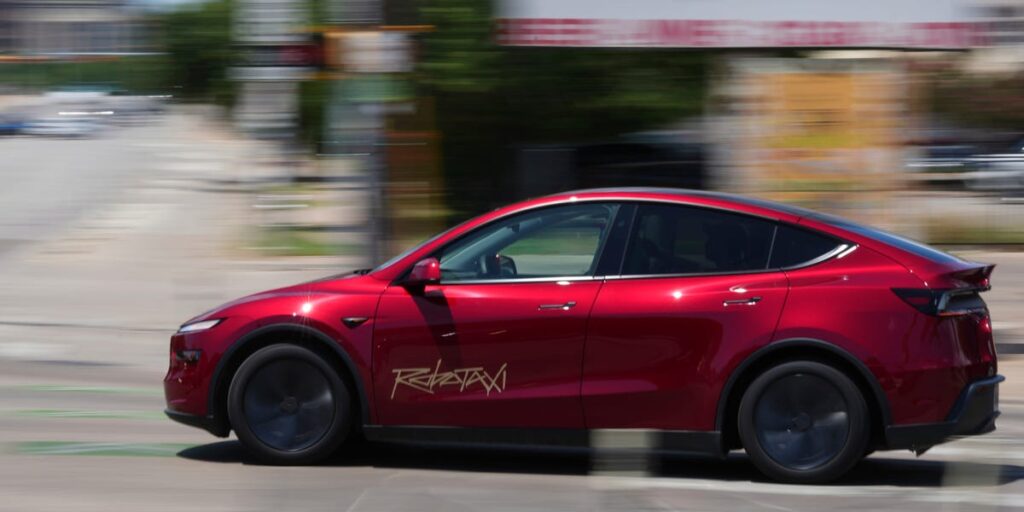Tesla’s CEO, Elon Musk, makes bold projections for his ventures. Robotaxi is no exception.
Wednesday’s earnings call, however, didn’t give specifics on one big question: How is robotaxi’s pilot launch going in Austin? The self-driving car program launched in June.
“They’ve got to show progress, and that’s what we didn’t get,” Gene Munster, a managing partner of Deepwater Asset Management who writes about Tesla and Alphabet, told Business Insider.
Here’s what Ashok Elluswamy, Tesla’s VP of AI software, said after an analyst asked for key performance indicators around robotaxi, including the number of vehicles Tesla is operating, miles driven autonomously, and the number of safety-critical interventions:
“We have more than 7,000 miles operating in Austin area. Just because service is new, we have a handful of vehicles right now, but then we are trying to expand the service in terms of both the area and also the number of vehicles, both in Austin and other locations. So far, there’s like no notable safety critical incidents. Sometimes we have our own restrictions as to, for example, we restrict our speeding limit to 40 miles per hour … and if the vehicle wants go on like higher speed roads, we can stop the vehicle, but those are out of convenience as opposed to safety critical nature. So far this service has been really well received, and we continue to expand on it.”
In short, a couple of vehicles drove about 7,000 miles in Austin without alarming safety issues.
The lack of critical safety incidents is great news for investors, but otherwise, there were not many other details.
Musk said on Wednesday’s call he expects autonomous Teslas to be available to “probably half of the population of the US by the end of the year,” pending government approval.
That’s a lot of places that Tesla would need to cover and a lot of regulatory hoops to jump through in roughly five months.
Tesla recently expanded robotaxi’s service area in Austin, just a few weeks after it debuted to a limited number of invitees. On X, the company and Musk proudly showed a phallic-shaped geofence expansion that essentially said to competitors, “Mine is bigger than yours.”
In that move, Tesla made no mention of how many robotaxis it would add to the roads or whether it would invite more people to meet the potential increased demands of a larger service area.
So far, we only know the figures Musk gave during April’s earnings call, when the CEO said Tesla would start with 10 to 20 Model Ys. The service is still limited to invite-only.
Tesla and a few folks on the company’s Autopilot team didn’t respond to questions posed on X about the vehicle numbers.
A spokesperson for Tesla did not respond to a request for comment from Business Insider.
What analysts want from Tesla
Analysts told BI they would like to see a few robotaxi data points.
Right now, a safety monitor sits on the front passenger side of every robotaxi. Data around human intervention or miles driven per disengagement is crucial because it can give investors some insight into when Tesla may feel confident enough to remove the human safety monitor, Munster said.
In one of my rides in Austin, a safety monitor had to stop the ride as the vehicle started to head toward the wrong direction on a one-way road.
“I think big picture is this: They’re not comfortable at removing the observer right now because they know the smallest mess up on safety is going to be just a huge blow to them. And I don’t blame them for going slow at it,” Munster said. “I just wish that three months ago, when they launched, they would’ve said, ‘Just so you know, we’re really prioritizing safety here. It’s going to be slow in Austin.'”
Jose Asumendi, JPMorgan’s head of European automotive research, told BI that if Tesla can get to a stage in Austin where robotaxis can drive people from one point to another and operate in different weather, it would mark “a stage of advanced development rather than an initial phase.”
Moving forward, Asumendi said that he’ll be paying attention to three data points to track robotaxi’s progression: number of cities the service has been deployed, number of accidents and disengagements per kilometer, and the technology’s acceptance by the public.
Tesla’s stock fell about 4.4% after trading hours on Wednesday after the company reported revenues that were down 12% year over year and missed Wall Street expectations.
The stock was down 8% on Thursday and is down 24% year to date.
Read the full article here


